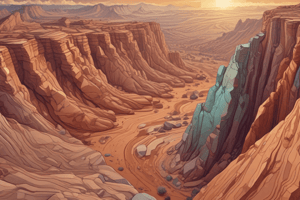Podcast
Questions and Answers
What is the outermost layer of the Earth made of?
What is the outermost layer of the Earth made of?
- Minerals
- Rocks (correct)
- Soil
- Water
What happens to rocks over time?
What happens to rocks over time?
- They remain unchanged forever
- They disappear into thin air
- They turn into water
- They are broken down and reformed (correct)
What is the process by which rocks are broken down into smaller pieces?
What is the process by which rocks are broken down into smaller pieces?
- Erosion
- Deposition
- Weathering (correct)
- Metamorphism
What is the rock cycle?
What is the rock cycle?
What is the term for rocks formed from broken fragments of older rocks and minerals?
What is the term for rocks formed from broken fragments of older rocks and minerals?
What are rocks composed of?
What are rocks composed of?
What is the process of rocks being pushed deep into the Earth and melting?
What is the process of rocks being pushed deep into the Earth and melting?
What is the term for the process of rocks changing form under high pressure and temperature?
What is the term for the process of rocks changing form under high pressure and temperature?
What happens to rocks when they are pushed deep into the Earth?
What happens to rocks when they are pushed deep into the Earth?
What is weathering?
What is weathering?
What type of rock is formed from interlocking mineral crystals?
What type of rock is formed from interlocking mineral crystals?
What is the purpose of the rock cycle?
What is the purpose of the rock cycle?
What is the term for the process of sediment settling and accumulating?
What is the term for the process of sediment settling and accumulating?
What is the term for the process of rocks being uplifted and buried?
What is the term for the process of rocks being uplifted and buried?
What is a mineral?
What is a mineral?
What is the term for the cycle of rock formation, transformation, and destruction?
What is the term for the cycle of rock formation, transformation, and destruction?
What is the term for the broken up pieces of rock that are transported away by rivers, glaciers and wind?
What is the term for the broken up pieces of rock that are transported away by rivers, glaciers and wind?
What happens to magma or lava when it cools down and turns from liquid to solid?
What happens to magma or lava when it cools down and turns from liquid to solid?
Why do igneous rocks formed from cooling lava, such as basalt, only have tiny crystals?
Why do igneous rocks formed from cooling lava, such as basalt, only have tiny crystals?
What can get trapped in sedimentary rocks?
What can get trapped in sedimentary rocks?
What is obsidian?
What is obsidian?
How do sediments become a sedimentary rock?
How do sediments become a sedimentary rock?
What can sedimentary rocks contain?
What can sedimentary rocks contain?
Why do crystals in magma deep within the Earth have more time to grow?
Why do crystals in magma deep within the Earth have more time to grow?
What can be seen under a microscope in an igneous rock that has formed deep within the Earth?
What can be seen under a microscope in an igneous rock that has formed deep within the Earth?
What happens when a permeable rock is put in water?
What happens when a permeable rock is put in water?
What determines the type of metamorphic rock formed?
What determines the type of metamorphic rock formed?
What is the characteristic of a non-porous and impermeable rock?
What is the characteristic of a non-porous and impermeable rock?
What is the difference between fast cooling and slow cooling in the formation of igneous rocks?
What is the difference between fast cooling and slow cooling in the formation of igneous rocks?
What is the type of rock that has been changed over time?
What is the type of rock that has been changed over time?
What is the term for gaps between the grains in a rock?
What is the term for gaps between the grains in a rock?
What is the name of the type of rock that is formed from lava?
What is the name of the type of rock that is formed from lava?
What occurs to rocks when they are pushed deep into the Earth?
What occurs to rocks when they are pushed deep into the Earth?
What is a characteristic of metamorphic rocks?
What is a characteristic of metamorphic rocks?
What is the result of metamorphism?
What is the result of metamorphism?
What is an example of a metamorphic rock?
What is an example of a metamorphic rock?
What causes the minerals in metamorphic rocks to line up to form layers?
What causes the minerals in metamorphic rocks to line up to form layers?
What is the difference between metamorphic rocks and igneous rocks?
What is the difference between metamorphic rocks and igneous rocks?
Flashcards are hidden until you start studying
Study Notes
The Rock Cycle
- The outermost layer of the Earth, called the crust, is made from rocks.
- Rocks can be broken down, moved around, and deposited in different places over thousands and millions of years.
- The rock cycle combines these processes.
What are Rocks?
- Rocks are made from a mixture of different minerals, which are solid chemical compounds that occur naturally on Earth.
- Rocks can be made from interlocking mineral crystals that fit tightly together or from broken fragments of older rocks and minerals cemented together.
Types of Rocks
- Igneous rocks: formed from the cooling and solidification of magma or lava.
- Sedimentary rocks: formed from the compaction of sediments, such as sand, mud, or fossils.
- Metamorphic rocks: formed from the transformation of existing rocks under high pressure and temperature.
Igneous Rocks
- Formed when magma or lava cools down and solidifies.
- Can have small or large crystals depending on the cooling rate.
- Can have gas bubbles trapped in them.
- Examples: basalt, granite, obsidian.
Sedimentary Rocks
- Formed from the accumulation and compaction of sediments.
- Can contain fossils of animals and plants.
- Can have pores or gaps between the grains.
- Examples: sandstone, limestone, mudstone.
Metamorphic Rocks
- Formed from the transformation of existing rocks under high pressure and temperature.
- Can have new textures and minerals.
- Depends on the type of rock and the amount of heat and pressure.
- Examples: gneiss, marble, quartzite.
Rock Properties
- Permeability: the ability of water, air, or oil to flow through the rock.
- Porosity: the presence of gaps or pores between the grains.
- Examples: permeable rocks like sandstone, impermeable rocks like granite.
Studying That Suits You
Use AI to generate personalized quizzes and flashcards to suit your learning preferences.




